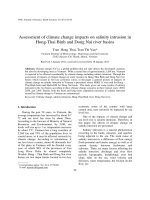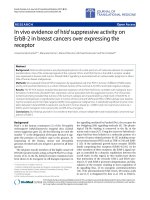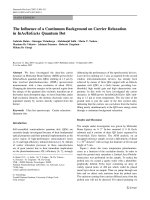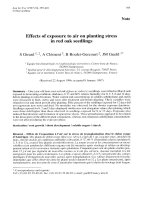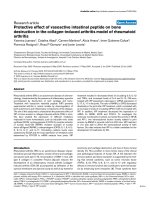Population dynamics of Exelastis atomosa (Walsingham) on pigeonpea genotypes in agro-ecosystem
Bạn đang xem bản rút gọn của tài liệu. Xem và tải ngay bản đầy đủ của tài liệu tại đây (246.7 KB, 6 trang )
Int.J.Curr.Microbiol.App.Sci (2017) 6(4): 2629-2634
International Journal of Current Microbiology and Applied Sciences
ISSN: 2319-7706 Volume 6 Number 4 (2017) pp. 2629-2634
Journal homepage:
Original Research Article
/>
Population Dynamics of Exelastis atomosa (Walsingham) on Pigeonpea
Genotypes in Agro-Ecosystem
Rahul Kumar*, Ram Keval and Vijay Kumar Mishra
Department of Entomology and Agricultural Zoology, Institute of Agricultural Sciences, Banaras
Hindu University, Varanasi-221005, Uttar Pradesh, India
*Corresponding author
ABSTRACT
Keywords
Pigeonpea crop,
Exelastisn atomosa
(Walsingham),
Population
dynamics
Article Info
Accepted:
25 March 2017
Available Online:
10 April 2017
Eighteen promising long duration pigeonpea genotypes were screened for their reaction against,
Exelastis atomosaat Agriculture Research farm, Institute of Agricultural Sciences, Banaras
Hindu University, Varanasi during kharif 2013-14 and 2014-15.During 2013-14 the first
incidence of Plume moth, Exelastis atomosa) was observed in 4th and 5thstandard week in all
genotypes. The peak of population of Plume moth, Exelastis atomosa was recorded in 11th
standard week (0.66 larvae/plant) in different genotypes. Among eighteen genotypes the mean
population was recorded highest in IPA 7-10 (0.54 larvae/plant) and lowest in KA 12-2 (0.17
larvae/plant) while during Second year the first incidence of plum moth was observed in 4th and
5th standard week in all genotypesand highest population was recorded in 12th standard week
i.e. 0.64 larvae/plant and lowest population was recorded in 4 th standard week i.e. (0.08
larvae/plant).Among eighteen genotypes the highest population was recorded on IPA 7-10
(0.55larvae/plant) while lowest population was recorded on KA 12-2 (0.15 larvae/plant). Hence
it may be concluded that incidence of plum moth increased with advancement of crop age and
actual damage takes place after flowering and among eighteen genotyes screened, none of them
was found free from infestation of plum moth, genotypeKA 12-2 shows least infestation i.e
resistant against Exelastis atomosa (Walsingham) infestation, whereas genotype IPA 7-10
shows highest infestation i.e susceptible against Exelastis atomosa(Walsingham) attack.
Introduction
India is one of the leading countries in pulse
production as well as consumption. It
accounts for 33 percent of world area and 24
percent of world production.The most
important states for pulses production are
Maharashtra, Uttar Pradesh, Madhya Pradesh,
Andhra Pradesh, Karnataka, Gujarat and
Bihar, which together account for more than
80 per cent of total pulses production. At
present the production of pulses is 18.34
million tonnes over an area of 23.26 million
hectares with productivity of 789 Kg/ha (EPulses data book IIPR, 2015). Pigeonpea
production is affected by several biotic and
abiotic stresses. Among biotic factors, the
seeds and other parts of the plant are fed upon
by many insects, with over 200 species
having been recorded in India alone. Some of
these insects cause sufficient crop losses to be
regarded as major pests, but the majority are
seldom abundant enough to cause much
damage, or are of sporadic or localized
importance, and regarded as minor pests. The
pod-damaging insect (Plume moth) cause
significant yield losses in pigeonpea and
therefore are the most important pests of this
crop. Pests that feed on reproductive
structures, flowers, and pods cause the
greatest harm. Foliar damage rarely reduces
seed yield. The post-harvest insect pests are
also considered significant in inflecting losses
2629
Int.J.Curr.Microbiol.App.Sci (2017) 6(4): 2629-2634
during storage. The plume moth in particular
often assume greater significance and are
recognized as the major constraints in
productivity (Rangaiah and Sehgal, 1984).
From different parts of the country occurrence
of a complex of pod borers had been reported
in pigeon pea (La1 et al., 1981; Khokhar and
Singh, 1983; Upadhyay et al., 1998). For
development of successful pest management
strategies, detailed information on the
population build up, in particular the
influence of weather factors on the population
dynamics is of great significance. The larva
was the damaging stage, which feeds on buds,
flowers and young pods and as a result of
feeding, small holes are seen on the buds and
tender pods. Plume moth infested ripened
pods show characteristic fungal attacked
grains which were brittle, blackened and unfit
for consumption. These findings are in
accordance with the findings of Srilaxmi and
Ravinda (2010); Subharani and Singh (2004)
and Yadav et al. (2009). The present study
focuses on the information on the population
build up and its influence with different
genotypes of pigeonpea, on which available
knowledge is scanty. So studies Population
Dynamics
of
Exelastis
atomosa
(Walsingham) on Pigeonpea Genotypes is
more important in of the pest management
strategy based on host plant resistance.
1st August during 2014-15 and harvested on
7th April 2014 and 10th April 2015
respectively. The whole plot was exposed to
natural infestation and no insecticides
applied.For recording the seasonal incidence
of insect pest, five plants were randomly
selected in each treatment and tagged. The
immature stages of pod borers present on
them were counted at weekly intervals, from
24th January to 28st march during 2013-14
and 2014-15. This practice was continued
throughout the pod formation stage. The
weekly observation on the number of larvae
and pupae in the sampled pods during both
the years was taken from 24th January to
28thmarch. The number of insect count
recorded from all the three replication for all
the genotypes were average separately for
each genotype on standard week basis from
all the replication of 18 genotypes/varieties of
pigeon pea.
Statistical analysis
All the data recorded were subjected to
statistical analysis as per the Randomized
Block Design procedure and insect population
data were transformed with square root
transformed √x+0.5 method.
Results and Discussion
Materials and Methods
Population dynamics of plume moth,
Exelastis atomosa (Walsingham)
The studies were carried out at Agricultural
Research Farm, Institute of Agricultural
Sciences,
Banaras
Hindu
University,
Varanasi, during Kharif, 2013-2014 and
2014-2015. The Eighteen long duration
pigeonpea genotypes/varieties were grown in
plots of 5 rows of 4 meters following row to
row and plant to plant spacing of 75 cm and
15 cm respectively. The crop was grown
following the normal agronomic practices in
"Randomized Block Design" with three
replications and eighteen treatments. The crop
was shown on 26th July during 2013-14 and
During 2013-14 the first incidence of Plume
moth, Exelastis atomosa was observed in 4th
standard week in nine genotypes i.e. DA 13-2,
MAL 40, MA 6, NDA 13-1, NDA 13-1, MAL
13, IPA 7-10, DA 13-1, BHUA 189. The
result revealed that the incidence of Plume
moth was recorded in all the pegionpea
genotypes at 5th standard week except KA 122 and KA 12-4 in which first incidence
recorded on 6th standard week. The peak of
population of Plume moth was recorded in
different genotype from 11th to 12th standard
week.
2630
Int.J.Curr.Microbiol.App.Sci (2017) 6(4): 2629-2634
Table.1 Plume moth, Exelastis atomosa (Walsingham) population on long duration pigeonpea genotypes during Kharif 2013-14
Population per plant
22th
Jan
29th
Jan
5th
Feb
12th
Feb
19th
Feb
26th
Feb
5th
March
12th
March
19th
March
26th
March
Average
DA 13-2
0.07(1.03)
0.15(1.07)
0.18(1.09)
0.27(1.13)
0.34(1.16)
0.39(1.18)
0.52(1.23)
0.60(1.26)
0.61(1.27)
0.16(1.08)
0.33
MAL 40
0.04(1.02)
0.07(1.03)
0.13(1.06)
0.19(1.09)
0.25(1.12)
0.33(1.15)
0.43(1.20)
0.63(1.27)
0.52(1.23)
0.15(1.07)
0.27
BAHAR(ch)
0.00(1.00)
0.03(1.02)
0.07(1.03)
0.14(1.07)
0.19(1.09)
0.22(1.10)
0.37(1.17)
0.49(1.22)
0.44(1.20)
0.07(1.03)
0.20
MA 6 (ch)
0.12(1.06)
0.20(1.10)
0.28(1.13)
0.38(1.18)
0.49(1.22)
0.57(1.25)
0.81(1.35)
0.99(1.41)
0.89(1.37)
0.3(1.14)
0.50
IPA 11-1
0.00(1.00)
0.13(1.06)
0.18(1.09)
0.20(1.10)
0.30(1.14)
0.35(1.16)
0.50(1.22)
0.69(1.30)
0.70(1.30)
0.19(1.09)
0.32
NDA 13-1
0.10(1.05)
0.15(1.07)
0.23(1.11)
0.35(1.16)
0.45(1.20)
0.53(1.24)
0.78(1.33)
0.88(1.37)
0.79(1.34)
0.24(1.11)
0.45
KA 12-2
0.00(1.00)
0.00(1.00)
0.04(1.02)
0.12(1.06)
0.13(1.06)
0.20(1.10)
0.35(1.16)
0.45(1.20)
0.37(1.17)
0.06(1.03)
0.17
NDA 1 (ch)
0.05(1.03)
0.12(1.06)
0.15(1.07)
0.21(1.10)
0.27(1.13)
0.34(1.16)
0.47(1.21)
0.65(1.28)
0.57(1.25)
0.19(1.09)
0.30
MAL 13(ch)
0.1(1.05)
0.07(1.03)
0.3(1.14)
0.34(1.16)
0.42(1.19)
0.53(1.24)
0.68(1.30)
0.67(1.29)
0.75(1.32)
0.23(1.11)
0.41
IPA 7-10
0.18(1.09)
0.13(1.06)
0.28(1.13)
0.42(1.19)
0.53(1.24)
0.65(1.28)
0.87(1.37)
1.08(1.44)
0.93(1.39)
0.32(1.15)
0.54
DA 13-1
0.07(1.03)
0.18(1.09)
0.15(1.07)
0.24(1.11)
0.21(1.10)
0.43(1.20)
0.67(1.29)
0.74(1.32)
0.59(1.26)
0.16(1.08)
0.34
NDA 13-2
0.00(1.00)
0.08(1.04)
0.13(1.06)
0.18(1.09)
0.24(1.11)
0.35(1.16)
0.55(1.24)
0.59(1.26)
0.52(1.23)
0.14(1.07)
0.28
BAUPP 09-22
0.00(1.00)
0.01(1.00)
0.10(1.05)
0.15(1.07)
0.20(1.10)
0.27(1.13)
0.39(1.18)
0.50(1.22)
0.45(1.20)
0.09(1.04)
0.22
MAL 39
0.00(1.00)
0.08(1.04)
0.12(1.07)
0.17(1.08)
0.25(1.12)
0.31(1.14)
0.45(1.20)
0.64(1.28)
0.56(1.25)
0.13(1.06)
0.27
KA 12-4
0.00(1.00)
0.05(1.03)
0.12(1.07)
0.16(1.08)
0.20(1.10)
0.29(1.13)
0.39(1.18)
0.53(1.24)
0.50(1.22)
0.05(1.03)
0.23
KA 12-3
0.00(1.00)
0.00(1.00)
0.05(1.03)
0.14(1.07)
0.18(1.09)
0.20(1.10)
0.36(1.16)
0.47(1.21)
0.39(1.18)
0.07(1.03)
0.19
NDA 2 (ch)
0.00(1.00)
0.07(1.03)
0.10(1.05)
0.19(1.09)
0.22(1.10)
0.31(1.14)
0.43(1.20)
0.58(1.26)
0.51(1.23)
0.11(1.05)
0.25
BHUA 189
Genotypes
0.07(1.03)
0.19(1.09)
0.15(1.07)
0.32(1.15)
0.29(1.14)
0.45(1.20)
0.57(1.25)
0.76(1.33)
0.60(1.26)
0.21(1.10)
0.36
Average
0.04
0.10
0.15
0.23
0.29
0.37
0.53
0.66
0.59
0.16
-
SEM±
0.007
0.011
0.013
0.018
0.024
0.031
0.032
0.040
0.041
0.019
-
CD at 5%
0.020
0.031
0.037
0.052
0.070
0.089
0.093
0.115
0.119
0.055
-
Figures in parentheses are √x+0.5 transformed value
2631
Int.J.Curr.Microbiol.App.Sci (2017) 6(4): 2629-2634
Table.2 Plume moth, Exelastis atomosa (Walsingham) population on long duration pigeonpea genotypes during Kharif 2014-15
Population per plant
22
Jan
29
Jan
5
Feb
12
Feb
19th
Feb
26th
Feb
5th
March
12th
March
19th
March
26th
March
Average
DA 13-2
0.12(1.06)
0.21(1.10)
0.15(1.07)
0.20(1.10)
0.32(1.15)
0.38(1.17)
0.47(1.21)
0.62(1.27)
0.65(1.28)
0.27(1.13)
0.34
MAL 40
0.09(1.04)
0.12(1.06)
0.12(1.06)
0.18(1.09)
0.22(1.10)
0.32(1.15)
0.38(1.17)
0.55(1.25)
0.62(1.27)
0.21(1.10)
0.28
BAHAR(ch)
0.00(1.00)
0.05(1.03)
0.07(1.03)
0.12(1.06)
0.15(1.07)
0.20(1.10)
0.33(1.15)
0.41(1.19)
0.49(1.22)
0.15(1.07)
0.20
MA 6 (ch)
0.23(1.11)
0.27(1.13)
0.21(1.10)
0.35(1.16)
0.45(1.20)
0.52(1.23)
0.77(1.33)
0.38(1.35)
0.89(1.37)
0.34(1.16)
0.44
IPA 11-1
0.11(1.05)
0.15(1.07)
0.09(1.04)
0.17(1.08)
0.27(1.13)
0.35(1.16)
0.52(1.23)
0.59(1.26)
0.66(1.29)
0.22(1.10)
0.31
NDA 13-1
0.18(1.09)
0.22(1.10)
0.25(1.12)
0.32(1.15)
0.40(1.18)
0.31(1.14)
0.73(1.31)
0.89(1.37)
0.88(1.37)
0.3(1.14)
0.45
KA 12-2
0.00(1.00)
0.05(1.03)
0.00(1.00)
0.09(1.04)
0.11(1.05)
0.17(1.08)
0.27(1.13)
0.35(1.16)
0.42(1.19)
0.00(1.0)
0.15
NDA 1 (ch)
0.05(1.03)
0.13(1.06)
0.12(1.06)
0.22(1.10)
0.25(1.12)
0.31(1.14)
0.60(1.26)
0.59(1.26)
0.66(1.29)
0.23(1.11)
0.32
MAL 13(ch)
0.13(1.06)
0.10(1.05)
0.28(1.13)
0.25(1.07)
0.38(1.18)
0.49(1.22)
0.58(1.26)
()0.72(1.31)
0.82(1.35)
0.29(1.14)
0.40
IPA 7-10
0.20(1.10)
0.39(1.15)
0.30(1.14)
0.39(1.18)
0.49(1.22)
0.60(1.27)
0.81(1.34)
0.97(1.40)
0.98(1.41)
0.36(1.17)
0.55
DA 13-1
0.14(1.07)
0.17(1.08)
0.13(1.06)
0.33(1.15)
0.18(1.09)
0.42(1.19)
0.49(1.22)
0.65(1.28)
0.63(1.28)
0.23(1.11)
0.34
NDA 13-2
0.00(1.0)
0.13(1.06)
0.12(1.06)
0.15(1.07)
0.24(1.11)
0.30(1.14)
0.41(1.19)
0.56(1.25)
0.59(1.26)
0.20(1.10)
0.27
BAUPP 09-22
0.00(1.0)
0.05(1.03)
0.00(1.0)
0.13(1.06)
0.17(1.08)
0.23(1.11)
0.34(1.16)
0.46(1.21)
0.50(1.23)
0.00(1.00)
0.19
MAL 39
0.07(1.03)
0.07(1.04)
0.09(1.04)
0.16(1.08)
0.21(1.10)
0.29(1.14)
0.37(1.17)
0.54(1.24)
0.57(1.25)
0.18(1.09)
0.26
KA 12-4
0.00(1.0)
0.09(1.04)
0.00(1.0)
0.15(1.07)
0.20(1.10)
0.27(1.13)
0.39(1.18)
0.42(1.19)
0.52(1.23)
0.00(1.00)
0.20
KA 12-3
0.00(1.0)
0.07(1.04)
0.00(1.0)
0.11(1.05)
0.15(1.07)
0.17(1.08)
0.29(1.14)
0.37(1.17)
0.43(1.19)
0.00(1.00)
0.16
NDA 2 (ch)
0.00(1.0)
0.11(1.05)
0.10(1.05)
0.13(1.06)
0.17(1.08)
0.26(1.12)
0.34(1.16)
0.49(1.22)
0.55(1.24)
0.18(1.09)
0.23
BHUA 189
0.15(1.07)
0.19(1.09)
0.15(1.07)
0.28(1.13)
0.18(1.09)
0.48(1.22)
0.45(1.20)
0.69(1.30)
0.74(1.31)
0.12(1.06)
0.34
Genotypes
th
th
th
th
Average
0.08
0.14
0.12
0.20
0.25
0.34
0.47
0.59
0.64
0.17
-
SEM±
0.007
0.010
0.010
0.016
0.015
0.020
0.034
0.030
0.033
0.017
-
CD at 5%
0.021
0.029
0.029
0.048
0.044
0.057
0.098
0.088
0.095
0.050
-
2632
Int.J.Curr.Microbiol.App.Sci (2017) 6(4): 2629-2634
Fig.1 Population fluctuation of Plume moth on different long duration pigeonpea
genotypes/varieties
Fig.2 Seasonal incidence of Plume moth on long duration pigeonpea
The peak population of plum moth was observed
on 11th standard week except DA 13-2, IPA 11-1
& NDA 1 in which peak observed on 12th
standard week.
Among the eighteen genotypes/varieties, the mean
population of Plume moth was recorded highest in
genotype IPA 7-10 i.e. (0.54 larvae/plant)
followed by MA-6 (0.50 larvae/plant), NDA 13-1
(0.45 larvae/plant), and lowest in genotype i.e.
KA 12-2 (0.17 larvae/plant) followed by KA 12-3
(0.19
larvae/plant),
BAHAR
(0.20
larvae/plant).The mean population of plum moth
was recorded highest in 11th standard week i.e.
0.66 larvae/plant followed by 12th standard week
(0.59 larvae/plant) and lowest population was
recorded in 4th standard week i.e. (0.04
larvae/plant).
During 2014-15 the first incidence of Plume moth,
Exelastis atomosa was observed on 4th standard
week in all genotypes except BAHAR, KA 12-2,
NDA 13-2, BAUPP 09-22, KA 12-3, NDA 2 in
which first incidence observed on 5th standard
week. The peak of population of Plume moth was
recorded in different genotype from 11th to 12th
standard week. The peak population of plum moth
was observed on 12th standard week on all
genotypes except DA 13-1 & NDA 13-1 in which
peak observed on 11th standard week.Among the
eighteen genotypes/varieties, the mean population
of Plume moth was recorded highest in genotype
IPA 7-10 i.e. (0.55 larvae/plant) followed by NDA
13-1 (0.45 larvae/plant) MA-6 (0.44 larvae/plant),
and lowest in genotype i.e. KA 12-2 (0.15
larvae/plant) followed by KA 12-3 (0.16
larvae/plant), BAHAR (0.20 larvae/plant).The
2633
Int.J.Curr.Microbiol.App.Sci (2017) 6(4): 2629-2634
mean population of plum moth was recorded
highest in 12th standard week i.e. 0.64 larvae/plant
followed by 11th standard week (0.59 larvae/plant)
and lowest population was recorded in 4th
standard week i.e. (0.08 larvae/plant).Present
investigation related with,Senapatiet al. (2000),
who recorded its incidence from middle of
October to middle of February with peaks in
fourth week of October, third and fourth weeks of
January on early, medium and late duration
varieties, respectively, in Orissa.Kumar and Nath
(2005)reported the average population of
Exelastis atomosa 0.92 plants.Chavanet al.,
(2010)conducted field studies to determine the
resistance of 11 pigeonpea genotypes against
Exelastisatomosa. Pawar et al.,(2014) was
reported that First appearance of the red gram
plume moth larva was observed when the crop age
was about 130 days, 47th SW,From the evident
that the pest was present on the crop during the
reproductive stage and remained available upto
the first week of January, 1st SW i.e. maturity
stage of the crop (172 CAD).
References
Annonymou,2015.moditiescont
rol.com/eagritrader/commodityknowlde
ge/redgram/redgram.1.htm#,accessed .
Chavan, A.P., Bramhane, R.O., Shinde, V.B.
andHarer, P.N. 2010. Resistance against
pod borer complex in.Journal of
Maharashtra
Agricultural
Universities,35(3): 469-470
Khokhar. K.S. and Singh, Z. 1983. Insect pests
associated with pigeon pea at Hisar,
India
international
pigeonpea
newsletter, 3: 43- 45.
Kumar, A. and Nath, P. 2003. Pest complex and
their population dynamics on mediumlate variety ofBahar. Indian Journal
ofPulses Research, 16(2): 150-154.
Lal, S.S ,Yadava, C.P and Das, C. A.R.
1981.Major pest problems of pigeon pea
In U P, lndialnternational Plgeonpea
Newes letter. 1: 30 -31.
Pawar,U.A., Chintkuntalawar, P.S., AND
Ugale, T.B. 2014. Studies on succession
of insect pest complex and their natural
enemies in pigeonpea [Cajanus cajan
(L.) Millsp. International Journal of
Plant Protection.,7 (2): 318-324.
Rangalah, P.V. and Sehgal, V.K. 1984.
Estlmation of crop losses in pigeon pea
due to Insect pests associated with in
various stages of its growth. Indian
Journal of Plant Breeding, 12: 127 130.
Senapati, B.,Sahoo, B.K.,Kulat. S.S. and
Bodhade, S.N. 2000.Insect pests of
pigeonpea
and
their
management.ApplledEntoomolog, insect
pests of pulses & oilseeds and their
manngemen. 2, 28- 53.
Srilaxmi, K. and Ravinda P. 2010. Diversity of
insect pests of pigeonpea [Cajanus cajan
(L.) Millsp.] and their succession in
relation to crop phenology in Gulbarga,
Karnataka. The Ecoscan., 4(4): 273-27.
Subharani, S. and Singh, T.K. 2004. Insect pest
complex of pigeonpea (Cajanus Cajan)
in agro-ecosystem of Manipur. Indian J.
Entomol., 66(3): 222-224.
Upadhyay, R.K. Mukherji, K.G. and Rajak,
R.L. 1998. IPM system in agriculture , 4
pulses, New Delhi. 99 pp
Yadav, R.S., Rai, S.N., Prasad, S. and Sing, J.
2009. Diversity of insect pests in
pigeonpea, Cajanus cajan (L.) Millsp, in
eastern Uttar Pradesh. Appl. Zool. Res.,
20(1): 127-131
How to cite this article:
Rahul Kumar, Ram Keval and Vijay Kumar Mishra. 2017. Population Dynamics of Exelastis atomosa
(Walsingham) on Pigeonpea Genotypes in Agro-Ecosystem. Int.J.Curr.Microbiol.App.Sci. 6(4): 26292634. doi: />
2634


